SoFi Stadium Went Up—and Then Everything Changed
It’s a sleepy Sunday morning in Inglewood, save for the never-ending parade of planes zooming overhead on final approach to nearby Los Angeles International Airport. But as the afternoon nears, the early-hour hush gives way to the usual crush of out-of-town visitors rumbling in.
“Oh s---. It’s crazy as hell,” Yolanda Johnson says. She’s standing outside her house on Arbor Vitae Street in mid-December doing what a lot of residents here do: waving a handmade cardboard sign stamped with “PARKING” as football fans slowly inch past her driveway on their way to SoFi Stadium for today’s game between the Chargers and Giants. She won’t tell me how much she charges to let strangers leave their cars at her house, but other residents say the going rate for the regular season is somewhere south of $100—which is a bargain compared with the outrageous prices parking spots are going for ahead of the Super Bowl. (There are Inglewood residents who told me they think they can cram five cars into their backyard for the big game—at $1,000 per car—and they live roughly a mile and a half from SoFi.)
Making some money on the side is a small consolation, though. Sometimes, just to get out of their driveway, Johnson’s husband has to stand in the street and stop traffic so she can back the car out. And if she has to run errands or work on a Sunday, things get dicey. Her job is about 15 minutes from her house—on a normal day. A couple of weeks ago, she had to work on a Sunday and it took her an hour to get home. Later today, she’s going shopping. She plans to stop by her sister’s house in Chino Hills and just wait there for a few hours until the game is long over and the fans are long gone.
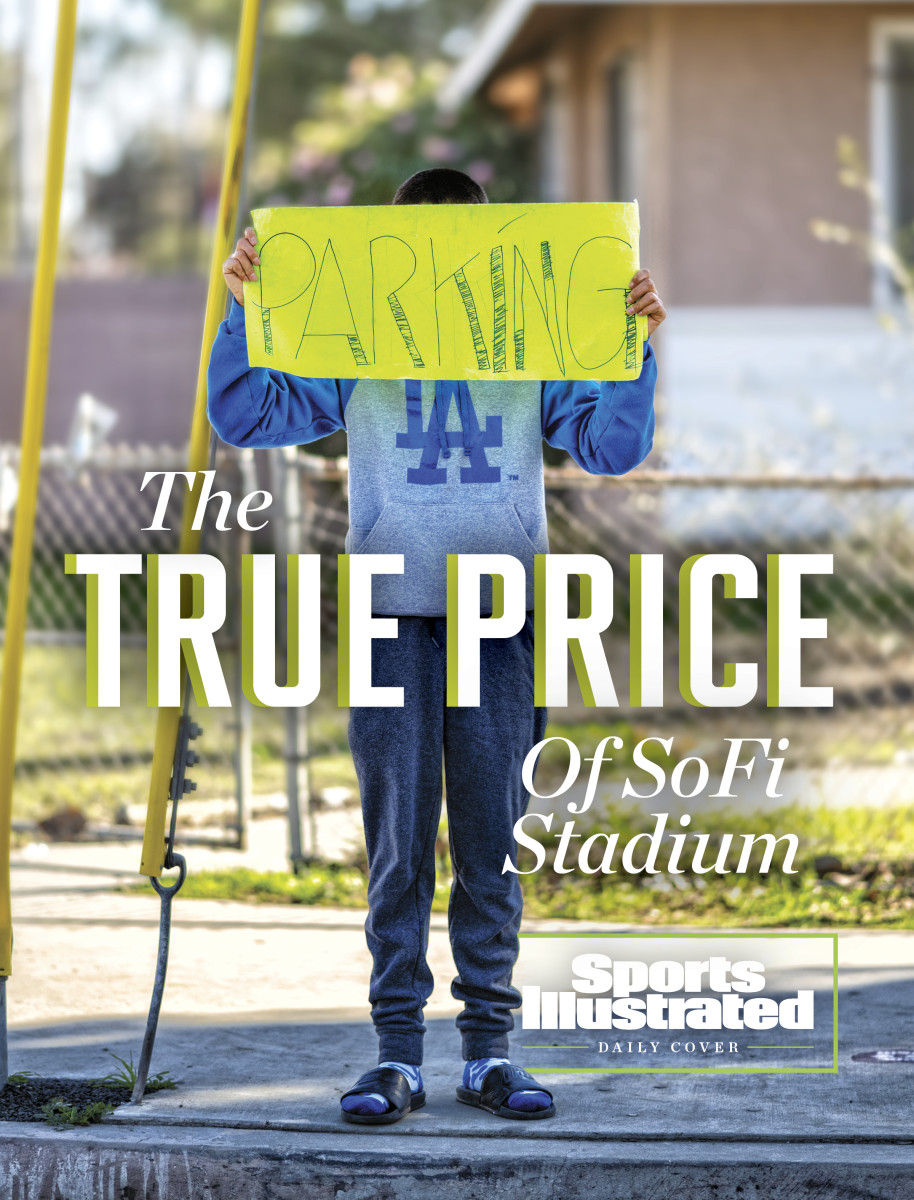
“It wasn’t as busy as this, at all,” Johnson says about what the neighborhood was like before SoFi opened. “We have The Forum over there, but it wasn’t as busy as it is now, especially on the weekends. It’s real hectic—traffic and all that. Loud. Loud, loud, loud. People coming and going.”
Not far from Johnson, one of her neighbors leans halfway out of his front door. He’s a big guy with messy hair and no shirt on, with a moderate belly that greets everyone as he shouts instructions. His name is Josh. He wants to make sure that a couple of fans who just parked on the street outside his place don’t get their car towed by the city. Like Johnson, Josh says it’s like this every weekend. He lives on Buckthorn Street. But barely a go-route away, just a few blocks east as it crosses Prairie Avenue, Buckthorn turns into Touchdown Drive, one of the many generically named conduits that funnel 70,000 football fans into SoFi Stadium each weekend to watch the Rams or Chargers. For Super Bowl LVI, the stadium will increase its capacity to 100,000, effectively doubling Inglewood’s population and bringing an even-bigger-than-usual circus to town.
The Bengals and hometown Rams will be most fans’ focus that day, but the stadium itself is a can’t-miss attraction. Literally. The view from Josh’s house is dominated by SoFi—a massive and beautiful (if incongruous) piece of architecture that looks like an alien edifice dreamed up for a Star Trek movie and then plunked down in Inglewood. The stadium is located next to the famed Forum, previously home to the Showtime Lakers, on land once occupied by Hollywood Park Racetrack. Unlike most major stadiums and arenas, SoFi was privately financed. Rams owner Stan Kroenke spared no expense, spending six years and at least $5 billion on the project—in a recent City Council meeting, the mayor of Inglewood pegged the price at $5.8 billion—making it the biggest football stadium ever created and the most expensive in the U.S., if not the world. Everything about the 3.1 million–square-foot facility is supersized—including the art collection, commissioned from 40 California artists to include “300 original pieces of work, 200 photographs, two hand-painted murals and 15,000 square feet of graphics.” As Cowboys owner Jerry Jones put it when asked about the stadium, “it’s iconic.”
Super Bowl LVI, the first NFL championship in L.A. in 29 years, is merely the kickoff to a long list of mega-events coming to Inglewood. Kenny Chesney will play the stadium in July. So will the Red Hot Chili Peppers. The college football national championship and WrestleMania 39 will be held there in 2023. In ’28, SoFi will host the opening and closing ceremonies, as well as soccer and archery, for the Summer Olympics. Big events for the big stadium are seemingly endless from here on out. And that’s without considering upcoming affairs at the Los Angeles Clippers’ new home, the $1.8 billion Intuit Dome, set to open next door in ’24.
Listen to the audio version of this story on our new podcast, Sports Illustrated Weekly
Not everyone is excited about all that activity. Members of the community have been raising questions and concerns since SoFi opened—about the increased traffic and noise, the influx of people into their neighborhood, the impact on local businesses and, perhaps most worryingly, the soaring home prices and rising rents that have already forced some residents out of town and threaten to push out many more.
In short, some of the people I spoke with in Inglewood are worried about Inglewood. It’s an incredible stadium. One of a kind. But as more than one resident asked, would you want to live next to it?
For his part, Inglewood Mayor James Butts is aware that some members of the community are uneasy with the fancy new addition to the neighborhood. But he’s also fine with the trade-offs that were made to bring SoFi to his city. He calls having the NFL in Inglewood “a statement” and describes what’s going on in his town as “a resurrection.”
“I couldn't be happier,” Butts says. To underline that point, the city paid for a promotion in the Los Angeles Times ahead of the Super Bowl hyping Inglewood’s renaissance. “When you think about it, there’s only three mega-cities in this country that have had the number of events and teams that we have in nine square miles and that’s San Francisco, New York and Los Angeles. But what took them a generation we did in less than seven years.”
Butts tells me he has this saying: “The only thing that’s changed in Inglewood is everything. Everything has changed here.”
On that point, everyone agrees.
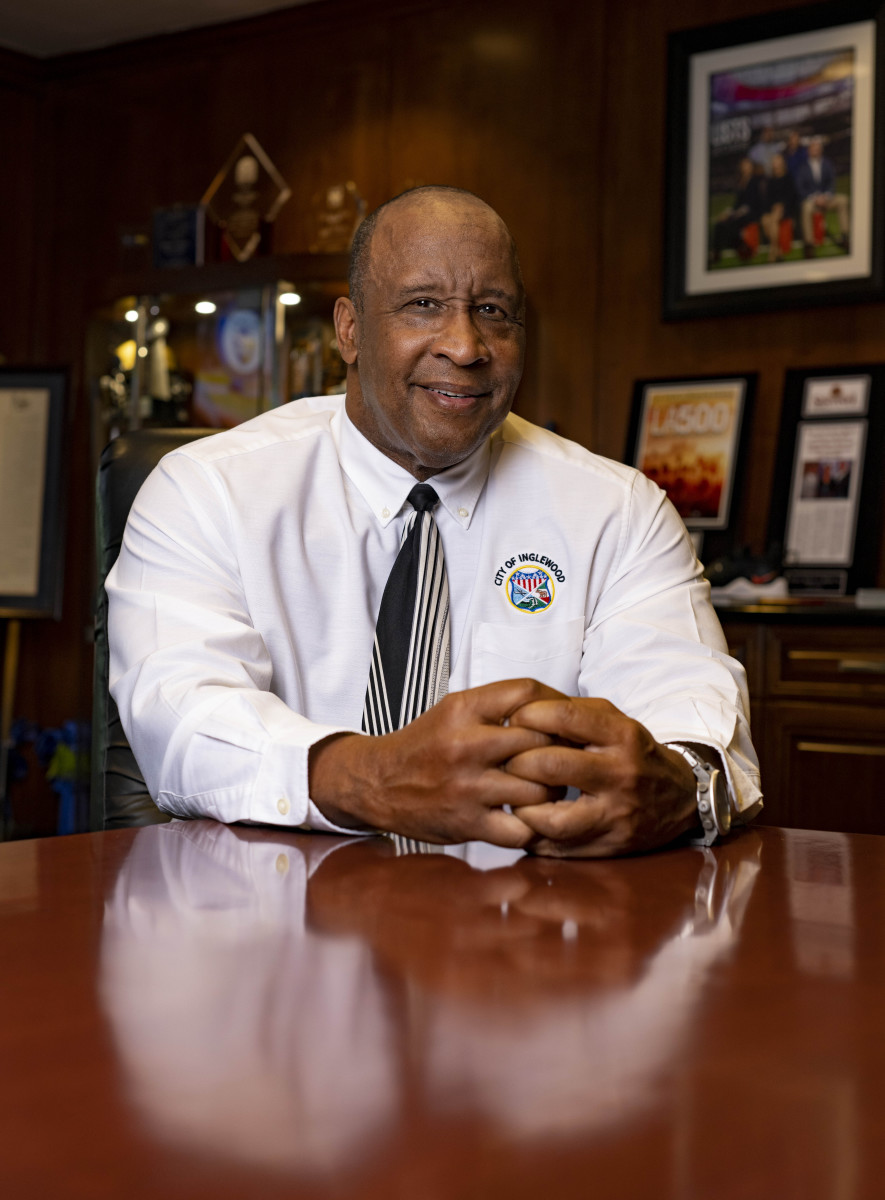
Aside from Kroenke, no one was more instrumental in bringing SoFi to Inglewood than Butts. (The Rams declined to make Kroenke available for this story.) Inglewood is one of 88 incorporated cities in Los Angeles County, with a population of about 108,000 people, more than 90% of whom are Black, Hispanic or Latino according to the latest census data. For years, Inglewood, which runs up against LAX and the 405 freeway to the west, was one of the most affordable communities in notoriously expensive L.A. It is also one of the poorest. Between 2015 and ’19, the median household income was $54,400, compared to $68,044 for L.A. County as a whole. When the Rams started looking for a place to build a new stadium and relocate from St. Louis to Los Angeles, Inglewood officials immediately put up their hands. The land already existed, and the town had a history of catering to sports teams. It seemed like a happy union. (The Chargers contributed a $200 million loan from the NFL toward the construction costs and chip in revenue generated from suits and seat licenses. In return, they pay $1 a year as tenants.)
The partnership between Inglewood and the Rams is just beginning. SoFi is part of a 298-acre multiuse development that calls for the construction of retail shops, restaurants, office space, a hotel and residential housing.
To hear Butts tell it, bringing SoFi to his city is an unqualified win and an economic success story. When he was elected in January 2011, one of his first efforts was to revitalize The Forum. Back then, he says Inglewood’s “bond rating was triple-B-minus at the time, which is one step above junk. We had $10 million in the bank. And we had an $18 million structural deficit.” He feared that by September or October of that year, “we would have been bankrupt.” Butts thought the surest way to avoid all that was to “make your city a destination.” With SoFi—and soon enough Intuit—he figures Inglewood has done just that.
But a destination for who? That’s what Miguel Alvarado, the pastor of Iglesia Hispana Central, has been wondering. He’s been at the church since 2004. It’s in a small, nondescript building sandwiched between a motel and a pest control company on Prairie Avenue, directly across the street from SoFi Stadium. On the December morning when we meet, he’s standing in the parking lot out back greeting his parishioners as they arrive, decked out in his Sunday best: dark suit and tie; crisp, white shirt.
Alvarado’s church has two services each Sunday: one at 10 a.m., the other at 6 p.m. Before SoFi Stadium was built, he says the traffic wasn’t too bad by L.A. standards. (If I might translate for the good pastor, that means it was still a special kind of hell.) Now, though, stadium traffic causes issues for both services. In the morning you have fans coming in for the standard 1 p.m. PT kickoff, and in the late afternoon you have fans leaving. As a result, Alvarado says, some of his flock no longer come to church because “they don’t want to deal with the traffic.”
“The traffic is the issue here,” Alvarado says. “And not only the traffic, but the people, too. Because people who never live here, they’re coming in. Another thing is, they’re pulling people out from the neighborhood because the rent, the houses, is very expensive now.”
Just this morning, in fact, Alvarado says a member of his church told him he was moving his family to Lancaster, a city slightly larger than Inglewood that’s about two hours north. He told Alvarado they couldn’t afford Inglewood anymore.
“It’s more expensive,” Alvarado says. “It’s going up. Everything is going up.”
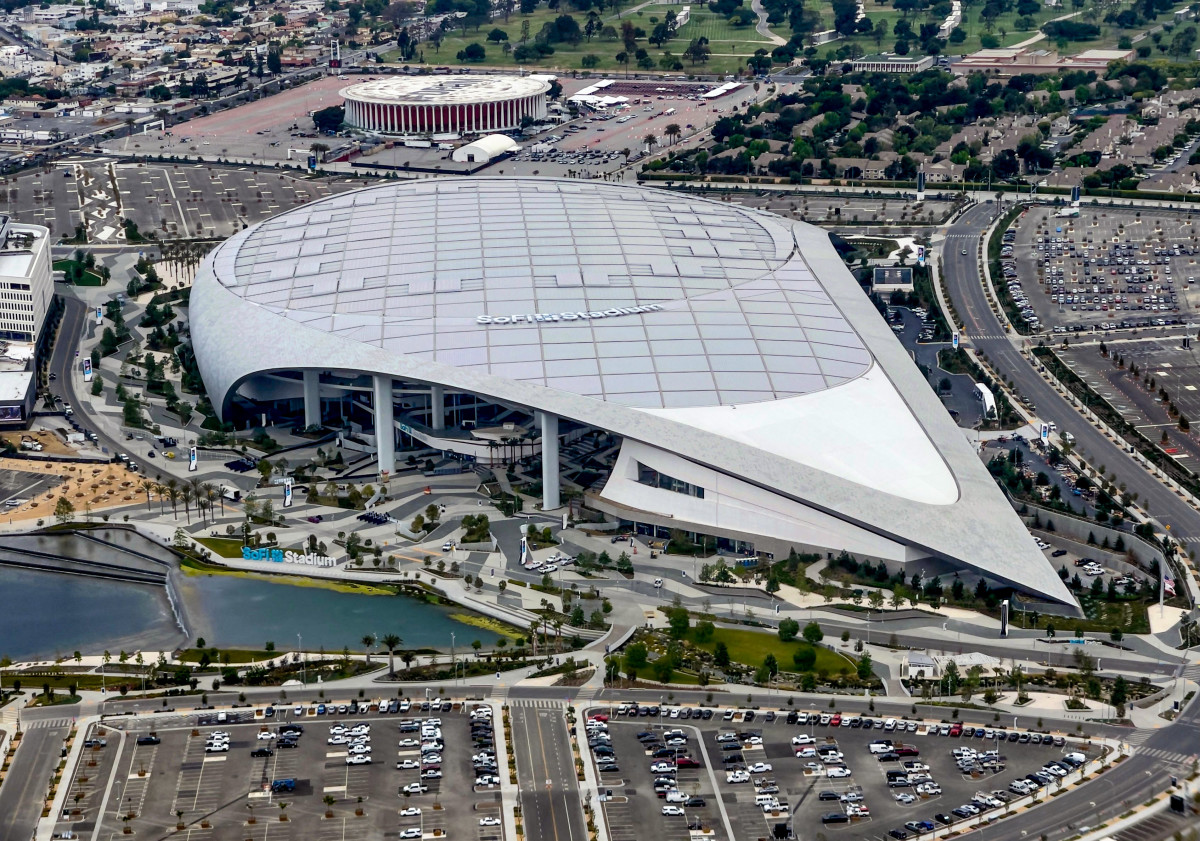
Alvarado says he’s concerned about the neighborhood and what will happen to people who have lived there for years. He has reason to worry. In January 2016, the NFL announced the Rams were moving to L.A. and that the Chargers would have the option to join them. In the first quarter of that year, the median sale price on a home in Inglewood was $345,000, according to PropertyShark.com. As of the last quarter of ’21, the median sale price had ballooned to $655,000—an increase of 90%. (Home prices have lately swelled nationwide, but not to the same extent: By comparison, over the same period, prices in Los Angeles proper increased by 60%.) Butts sees that as a good thing. He calls it “huge” and trumpets families that now have “generational wealth to pass on to their children.” Indeed, for home owners it’s been a boon. But according to the latest census data, only 35.8% of the city’s housing units were owner-occupied. Put another way, most people in Inglewood rent.
Not surprisingly, rent prices have also increased over the last five years. According to Zumper, which tracks rent data, the average price for a one-bedroom apartment in Inglewood in January 2016 was $1,100. As of January 2022, the average had spiked to $1,750—an increase of 59%. (Over the same period, Los Angeles’s rent increased by 17%.) Inglewood has a 3% rent-control cap in place to prevent price gouging, but various loopholes have nevertheless provided the wiggle room for some landlords to charge more money. Still, Butts touts the rent cap as “the lowest in the state of California” and points out that Inglewood has some of the cheapest rents in the South Bay area of Los Angeles—much lower than far pricier beachfront communities like Manhattan Beach, Hermosa, Redondo and Palos Verdes.
“So what is it that you would have of us?” Butts asks when I mention the rising housing costs. “I've heard this said before. But the alternative is to be crime-ridden, to have no job-generating businesses in town. To have no drive-through traffic that spends money where the taxes stay with the residents. And then, you know what? Then you'll have very, very cheap [rent]. But you'll have a very undesirable city to live in.”
Rather than equivocating or obfuscating as some politicians are wont to do, Butts takes every opportunity during our conversation to voice his unwavering support for SoFi. His enthusiasm for the project has sometimes created PR problems. During a recent City Council meeting, the mayor admonished some constituents for suggesting the Rams should pay for a proposed people mover that would connect to the nearby Crenshaw Metro line as a make-good to the neighborhood, scolding them that “This is our responsibility. It’s not enough to say ‘Oh, somebody else should pay for it.’ That’s not what mature adults do.” Following a different City Council session—as these things go, Inglewood’s civic gatherings are can’t-miss—Butts was apparently caught on an open mic telling an activist to “go choke yourself” after she was critical of the Clippers’ use of public land to hold a press conference. (Butts has claimed he has no recollection of saying it. The video of the meeting on the city website has been edited to end before the statement occurred, though activists have posted what they say is the original footage, where the statement can be clearly heard.)
While all that might not be great political optics for the mayor, Derek Steele understands where Butts is coming from, even if he doesn’t necessarily agree. Steele has lived in Inglewood since 2008. He’s an activist for Uplift Inglewood, an organization created in ’15 that aims to provide a voice for residents during a time of rapid change in the city. Steele credits the mayor for engaging with his constituents about what that change should look like, and he says that while “the convo has its contentious parts, all parties have the community’s best interests at heart.” He stresses that. He loves Inglewood. He stresses that, too. But Steele says it all got real for him when his daughter started losing friends at school. “It's like, well, why did they have to move? Oh, yeah. The rent went up a thousand dollars,” Steele tells me. He says stories like that hurt his heart. When it comes to rent, Steele insists that for people in Inglewood, “it's not about cheap. It is about affordability. Because when you're talking about affordability, you're looking at what people can actually afford to spend.”
The tipping point between what residents can and can’t afford—something that’s impacting renters nationwide—is what troubles him and others in Inglewood most. Estefany Castaneda has lived in Inglewood and Lennox (an unincorporated part of L.A. County neighboring Inglewood) her whole life. So has most of her family. The 25-year-old community organizer is part of the Lennox-Inglewood Tenants Union, which bills itself as “a grassroots community organization dedicated to fighting for the rights of renters.” Castaneda says she feels “a mixture of frustration and disappointment” over the housing shortages and rising costs. She agonizes over “a large population of folks that are a paycheck away, a hundred-dollar increase away from having to move because the cost of living continues to go up.”
It’s part of why the stakes here are so high. If Inglewood represents one of the few affordable communities in L.A. County, that doesn’t leave many options for lower-income residents as housing costs spike. Like Alvarado’s parishioner, some people might move farther away to places where they could potentially get more for their money and lower their cost of living. But in some circumstances, that also means increasing the time they spend commuting to work. And then what?
“The other side of what [Butts is] saying is, if Inglewood is the most affordable place to actually live in the South Bay,” Steele says, “then when people are displaced from here, where are they going?”
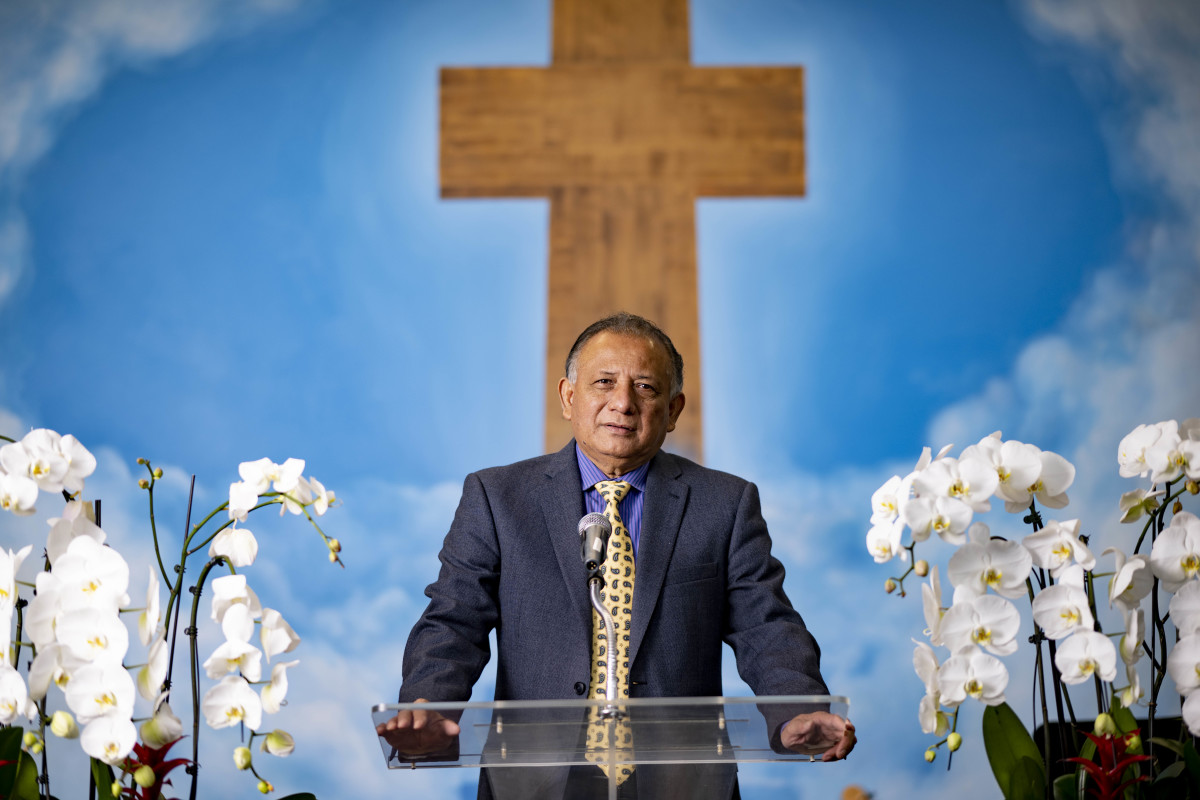
If the economic impact report commissioned by the Los Angeles Super Bowl Host Committee is to be believed, they shouldn’t have to go anywhere. The report was conducted by a company called Micronomics, an economic research and consulting firm with offices in L.A. and Long Beach. Unsurprisingly, it predicts the Super Bowl will greatly benefit Inglewood.
Based on the report’s “most likely” estimates, it projects the city will “realize up to $52 million in economic activity and generate close to $2 million in tax revenue that stays in Inglewood from Super Bowl LVI alone.” The report went so far as to say those gains are associated with “an increase of up to 800 annual jobs.” The study further outlines philanthropic efforts around the Super Bowl that include planting 56 trees at an Inglewood park, a separate program that will “identify and support” 26 businesses in Inglewood owned by people of color, women, LGBTQ+ people and veterans, and a “festival-style event” in Inglewood that will feature “fun activities for kids to both get them moving and introduce them to community service activities,” as well as “various other youth actions/programs in and around Inglewood.” In all, it paints a glowing picture of a boom town that will thrive thanks to hosting the big game and having SoFi Stadium in town. (In preparation for the event, the Los Angeles Times reports, the city has cleared homeless encampments near the stadium.)
“This is the same old, same old that advocates for stadiums and for large events like Super Bowls and the Olympics have been saying for 20 and 30 years,” says Rick Eckstein, a professor of sociology and criminology at Villanova and coauthor of the book Public Dollars, Private Stadiums. Looking through the Super Bowl report, he says he sees the usual dubious methodology. “They come out with these documents, we like to call them advocacy studies—a colleague of mine calls them fantasy documents—and they're basically just a wish list and pie in the sky.
“Even though there's this real consensus among social scientists that these things do not bear economic fruit in the long run, the stadiums keep getting built and people keep justifying it with these economic arguments and folks in the media keep parroting it.”
Micronomics did not return multiple requests from Sports Illustrated for comment.
Eckstein also takes umbrage with the framing of SoFi and the Intuit Dome, as well as other stadiums and arenas, as privately financed. He says that conveniently ignores the public money involved in preparing the site, infrastructure such as sewers and electricity, and game-day public safety, which is usually paid for by communities rather than teams.
Andrew Zimbalist, a professor of economics at Smith College, offers many of the same overarching takeaways. He’s written several articles and books about the impact that stadiums and large events have on communities. He says, “Stadiums and arenas do not support higher per capita income, and they do not support employment.” Which doesn’t mean stadiums don’t change matters for area residents. Zimbalist believes they do, just in ways that aren’t necessarily as rosy as they’re portrayed.

In the case of Inglewood, he says the neighborhood is obviously gentrifying. As a result, he thinks home owners “might benefit a little bit because they can sell their land at a higher price, if it’s not taken by eminent domain.” The problem, he contends, is that most people in Inglewood rent and “get shafted.” That includes retail renters—business owners who don’t own their buildings and might get priced out of the neighborhood as higher-end shops and chains move in.
“You put all this together,” Zimbalist says, “and it’s very dubious.”
Butts pushes back on all of this—especially the complaints from his constituents about traffic. When he sees cars streaming into his city, he doesn’t see inconvenience, he sees exactly what’s written about in those reports: economic impact. At a City Council meeting in December, Butts cited an environmental impact report that said Inglewood has “plenty of capacity on your roadways” and added, “We want to have the least impact for our residents as possible. We want Inglewood to be the most desirable location possible for people to come to because they know they can get in and out.”
The mayor maintains congestion is nothing new for Inglewood, anyway. He says that during the 1970s, ’80s and ’90s, when The Forum was hosting several games a week and the racetrack was doing daily business, the area was every bit as busy as it is now. And where football games are mostly held on Thursday, Sunday or Monday, Butts says, “It was all week long before.”
That might be true, but there’s a big difference between 20,000 people for a basketball game and 70,000 people for a football game. (The difference is 50,000. I did the math.) Not to mention, with The Forum still holding events and the Clippers opening up shop in 2024, it will soon be all week long again.
When I raise all this with Butts, he is as undeterred as ever. He says residents “learn that if there’s an event” they don’t use certain streets, including Century, Manchester and Prairie, which sounds to me like a lot of main thoroughfares to avoid, but which the mayor dismisses as “common sense.” To Butts, the choice between less traffic and what traffic represents—“prosperity for the city, thousands of jobs for the residents, paved streets, [redoing] our water system,” which he says is 60 years old, “[trimming] your trees”—is no choice at all. If that means “you take alternative routes to come home,” the mayor is cool with that swap.
“So that’s my answer to that,” Butts says. “I mean, no situation is ideal. But I’ll tell you what, there are a lot of cities that would want to be in our situation. I’ll tell you that as a fact.”
If it’s merely a matter of being aggravated by the traffic, Butts makes the trade-off sound worthwhile. The problem, as Eckstein sees it, goes well beyond inconvenience. He calls Barclays Center in Brooklyn “the poster child” for how arenas impact urban areas. Eckstein says the community was pitched on “all the promises that there’s going to be all this stuff going on and all the people who’ve been living on Flatbush [Avenue] for years are going to be riding that gravy train.” Instead, he says, the local hardware and grocery stores are gone because they were priced out of the neighborhood and replaced with “posh restaurants popping up.” Eckstein imagines the same sorts of developments will unfold in Inglewood. And if residents are inconvenienced by the stadium, Eckstein thinks “it almost doesn’t matter” to the people who made building it possible. He points to where stadiums are located as a key point: predominantly middle-class and working-class neighborhoods where communities might not have the political or economic power to push back. So if residents are inconvenienced on game day, Eckstein says, that’s “better than inconveniencing people who could actually maybe do something about it.”
“They build it in places like Inglewood,” Eckstein concludes. “They’re not going to build it in Beverly Hills, put it that way.”
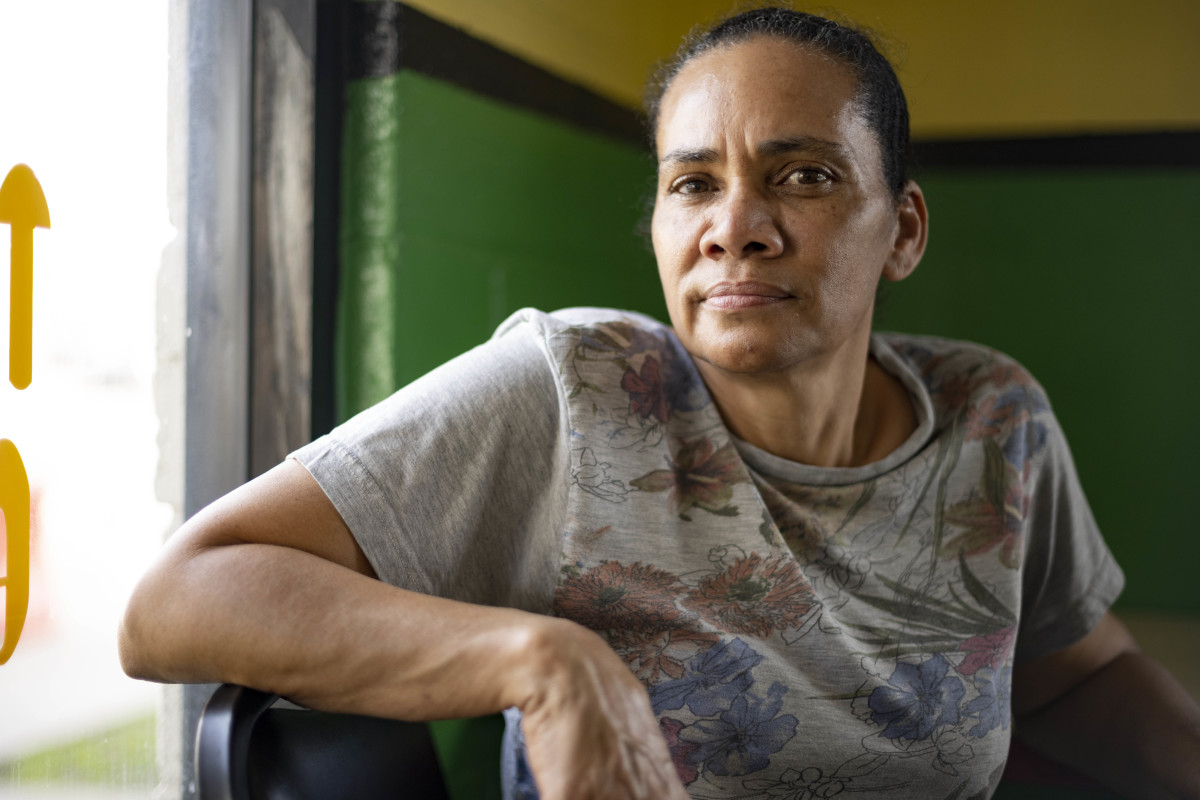
Sandra Estrada is the co-owner of Blessed Tropical Jamaican Cuisine, a small restaurant in a tiny strip mall across the street from SoFi Stadium. It’s been there for 13 years. She was worried that the pandemic would hurt their business, but she says “we did real good” during it. She thought once SoFi started admitting fans for the 2021 season it would make things even better.
“Everyone saying, ‘The stadium is coming and you guys gonna do good.’ But we not doing good with the stadium,” Estrada says. We’re standing outside her shop. She’s in a white T-shirt with her hair pulled back, and she has a couple of customers inside, but not nearly as many as she’d like. “The business went down really, really bad.”
Before SoFi came along, Estrada tells me she used to sell about 140 oxtails on Sunday. That’s her big day and their most popular dish. Most weeks she says they’d sell out by 7. Customers would come in, and she’d have to tell them the food was already gone. It was a huge chunk of their business—about $5,000 for Sunday alone. Now she says she’s “praying” to see customers come in and she feels lucky if they sell 80 oxtails on a Sunday. The week before we talked, they sold only 60.
Part of the problem is parking. The owner of the building rents out the lot on game day to fans. Blessed Jamaican has only a couple of spots on Sundays as a result—and it’s hard to get into the lot in the first place when there’s a game. That’s another issue. There are movable barriers set up on Sunday dividing the street outside her restaurant so that cars traveling west on Arbor Vitae can’t make a left into the lot to buy her food.
“I don’t know if it’s just because people can’t go in and out or what, or because of the traffic, I don’t really know,” Estrada says. “It’s just not good. My business is not good.”
When I relay Estrada’s story to the mayor, he says he’s “very sorry” that her business was better before SoFi opened but adds that “businesses operate under the system of capitalism we have in this country.” He tells me “it’s a little difficult to understand” how Estrada’s shop is suffering when “so many businesses benefit from the additional traffic.” He mentions that the Sizzler at the corner of Prairie and Manchester ran out of steak for the first time since he’s lived in the city, and he’s been there since 1972. He says another local haunt, Dulan’s, at the corner of Manchester and LaBrea, is “doing record business.” A Rams spokesperson also mentioned Dulan’s as one of the local restaurants that the team has a relationship with (Dulan’s catered events during the stadium construction), along with several others like Three Weavers Brewery, Woody’s BBQ and Sweet Red Peach, which I’m told is a particular favorite of team president Kevin Demoff. Leading up to the game against the 49ers in January, the Rams and Pepsi purchased meals for fans at The Serving Spoon. And for Juneteenth in 2020 and 2021, the Rams worked with area businesses to provide special promotions and giveaways to residents.
“So I don’t know how to respond to one individual situation,” Butts continues. “But I would tell you this: You have more opportunity if you sell things, if tens of thousands of cars come down your street than if none come down.”
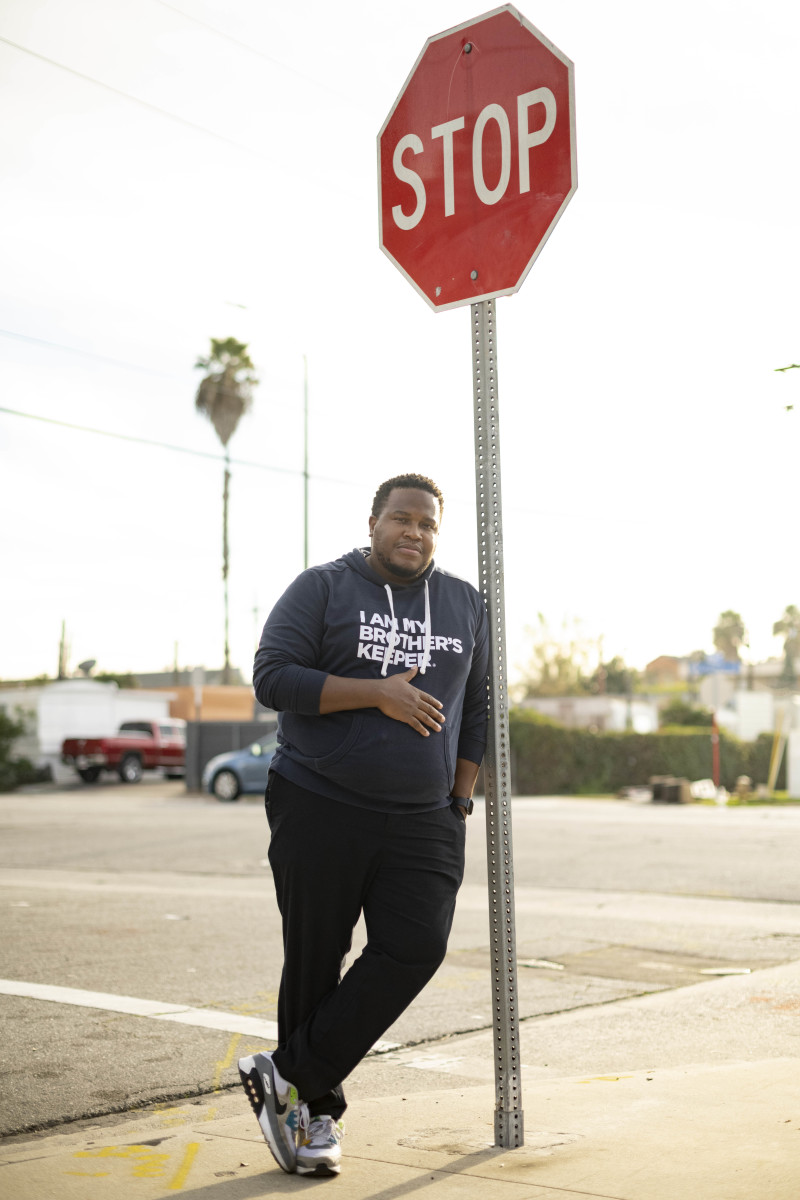
The mayor’s underlying point, as ever, is that SoFi is a net positive for Inglewood. And here he ticks off the many benefits as he sees them, including the stadium development agreement that called for a local hire goal of 35%. “So,” Butts tells me, “3,000 people a day worked on SoFi Stadium, and 1,200 of them on the average were Inglewood residents. We had a hard-to-hire provision, so that people that have been convicted of felonies could not be automatically excluded from employment. So we had over a hundred people that had served their debt to society that made between $60 and $90 an hour, working with the iron workers and the electrical union.”
Beyond that, Butts says Inglewood is finally financially stable. In addition to all the tree-trimming and water-system-fixing and library-upgrading the city can now afford, he says they’ve “paved and resurfaced more miles of roadway and more linear feet of sidewalk in the last seven years than the prior 40 years combined.” And in the process of all those improvements, the mayor boasts that Inglewood has attracted the LA Philharmonic youth orchestra program—which he proudly notes is “firmly settled 50 yards from City Hall”—and the Girl Scouts of Greater Los Angeles, who moved from nearby Marina del Rey. NFL Network, previously based in Culver City, also built a new headquarters next to the stadium, and YouTube has a 6,000-seat performing arts theater adjacent to SoFi. And the city started a youth tennis program for lower-income kids. All of which are possible, he argues, because SoFi pressed the reset button on the city.
An NFL spokesman also touts the league’s community-based initiatives, including a sports content lab at Inglewood High School, beautification efforts in the city, helping local small business owners with physical upgrades, Thanksgiving canned food drives, turkey giveaways and holiday gifts for the community, as well as a music education program for the neighborhood designed to foster local talent.
Butts is clearly pleased with the partnership between Inglewood and SoFi, but the way the stadium construction was approved in the first place suggests he and City Council weren’t completely confident that residents would have approved the build. Butts and the City Council used a loophole in state election law to avoid putting the stadium up for a vote. Instead, they gathered 22,000 signatures from registered voters, which gave Butts and the City Council the authority to vote it up or down. They approved it unanimously.
Butts later told USA Today that Inglewood “avoided the circus of an election,” and a SoFi Stadium spokesperson says those 22,000 signatures mean “the community was overwhelming in their support.” Butts also tells me it was “smart” for him and City Council to go that route because they had to be “decisive” and act fast to outmaneuver competitors in downtown L.A. and Carson that were also bidding for the stadium. When I ask how residents should feel about not having a vote in the matter, he answers with a question of his own.
“Was it legal, John?” Butts asks. “You said it was an ‘end-around.’ Was it legal?”
I concede that it was.
“O.K.,” Butts replies. “So it was within the law.”
The fact remains that Butts and the City Council ultimately got what they wanted. Steele admits that he thinks all the new activity in Inglewood is “a net positive”—provided that the community that was here before the stadium was built can remain in Inglewood and reap the benefits moving forward. That’s something he worries about. Steele went to SoFi for the Steelers-Chargers game in late November and had a great time. If other people in Inglewood have the opportunity for similar experiences, he’s all for it.
“But,” Steele says, “if it’s a situation on the other side where they’re getting displaced from it, they didn't even have a say in it, rents are being raised in ways that they can’t even take on and nobody’s doing anything about it, those things are not good, not only just for those adults in the space, but also the youth, because what does the future hold for them?”
That’s a fair question. But the answer, when and if it’s knowable, is also incidental at this point. The deed is already done. SoFi isn’t going anywhere, and neither is Intuit. For better or worse, it’s all part of the new Inglewood now. Besides, it’s not like the City Council or the mayor are offering apologies or second-guessing the situation. When I ask Butts whether he’d change anything about how everything has gone down, he’s unequivocal.
“I’m sorry,” he replies. “I can’t think of a thing that we would have done differently.”
• The Long, Strange Relationship Between the Super Bowl and Hollywood
• Al Michaels, on the Eve of What Might Be His Last Game
• It Hasn’t Been Easy for Joe Burrow; Just Ask His Parents
• Cooper Kupp’s Scientific Approach to Greatness
